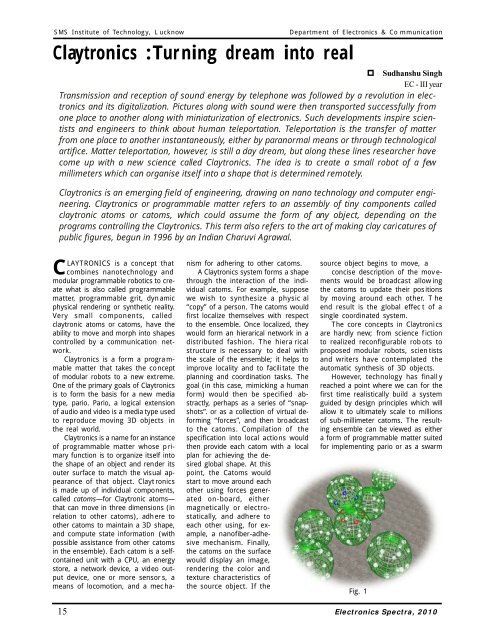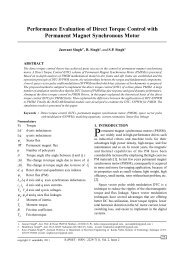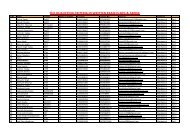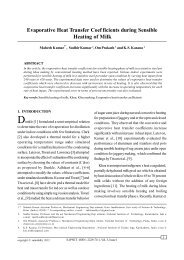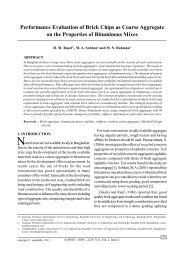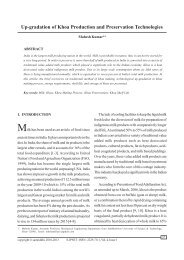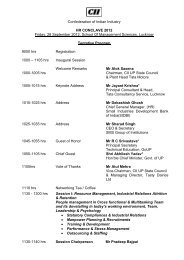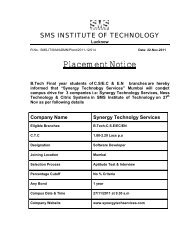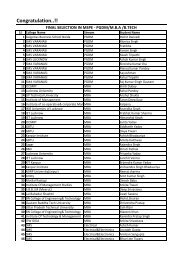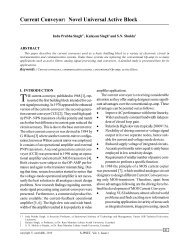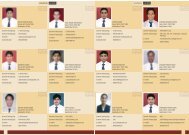Electronics Spectra - SMS Lucknow
Electronics Spectra - SMS Lucknow
Electronics Spectra - SMS Lucknow
You also want an ePaper? Increase the reach of your titles
YUMPU automatically turns print PDFs into web optimized ePapers that Google loves.
<strong>SMS</strong> Institute of Technology, L ucknow<br />
Claytronics : Turning dream into real<br />
Department of <strong>Electronics</strong> & Co mmunication<br />
Sudhanshu Singh<br />
EC - III year<br />
Transmission and reception of sound energy by telephone was followed by a revolution in electronics<br />
and its digitalization. Pictures along with sound were then transported successfully from<br />
one place to another along with miniaturization of electronics. Such developments inspire scientists<br />
and engineers to think about human teleportation. Teleportation is the transfer of matter<br />
from one place to another instantaneously, either by paranormal means or through technological<br />
artifice. Matter teleportation, however, is still a day dream, but along these lines researcher have<br />
come up with a new science called Claytronics. The idea is to create a small robot of a few<br />
millimeters which can organise itself into a shape that is determined remotely.<br />
Claytronics is an emerging field of engineering, drawing on nano technology and computer engineering.<br />
Claytronics or programmable matter refers to an assembly of tiny components called<br />
claytronic atoms or catoms, which could assume the form of any object, depending on the<br />
programs controlling the Claytronics. This term also refers to the art of making clay caricatures of<br />
public figures, begun in 1996 by an Indian Charuvi Agrawal.<br />
CLAYTRONICS is a concept that<br />
combines nanotechnology and<br />
modular programmable robotics to create<br />
what is also called programmable<br />
matter, programmable grit, dyn amic<br />
physical rendering or synthetic reality.<br />
Very small components, called<br />
claytronic atoms or catoms, have the<br />
ability to move and morph into shapes<br />
controlled by a communication network.<br />
Claytronics is a form a progra m-<br />
mable matter that takes the concept<br />
of modular robots to a new extreme.<br />
One of the primary goals of Claytronics<br />
is to form the basis for a new media<br />
type, pario. Pario, a logical extension<br />
of audio and video is a media type used<br />
to reproduce moving 3D objects in<br />
the real world.<br />
Claytronics is a name for an instance<br />
of programmable matter whose p rimary<br />
function is to organize itself into<br />
the shape of an object and render its<br />
outer surface to match the visual appearance<br />
of that object. Clayt ronics<br />
is made up of individual components,<br />
called catoms—for Claytronic atoms—<br />
that can move in three dimensions (in<br />
relation to other catoms), adhere to<br />
other catoms to maintain a 3D shape,<br />
and compute state information (with<br />
possible assistance from other catoms<br />
in the ensemble). Each catom is a selfcontained<br />
unit with a CPU, an energy<br />
store, a network device, a video output<br />
device, one or more sensor s, a<br />
means of locomotion, and a mec hanism<br />
for adhering to other catoms.<br />
A Claytronics system forms a shape<br />
through the interaction of the individual<br />
catoms. For example, suppose<br />
we wish to synthesize a physic al<br />
“copy” of a person. The catoms would<br />
first localize themselves with respect<br />
to the ensemble. Once localized, they<br />
would form an hierarical network in a<br />
distributed fashion. The hiera rical<br />
structure is necessary to deal with<br />
the scale of the ensemble; it helps to<br />
improve locality and to facili tate the<br />
planning and coordination tasks. The<br />
goal (in this case, mimicking a human<br />
form) would then be specified abstractly,<br />
perhaps as a series of “snapshots”.<br />
or as a collection of virtual deforming<br />
“forces”, and then broadcast<br />
to the catoms. Compilation of the<br />
specification into local actions would<br />
then provide each catom with a local<br />
plan for achieving the desired<br />
global shape. At this<br />
point, the Catoms would<br />
start to move around each<br />
other using forces generated<br />
on-board, either<br />
magnetically or electrostatically,<br />
and adhere to<br />
each other using, for example,<br />
a nanofiber-adhesive<br />
mechanism. Finally,<br />
the catoms on the surface<br />
would display an image,<br />
rendering the color and<br />
texture characteristics of<br />
the source object. If the<br />
source object begins to move, a<br />
concise description of the movements<br />
would be broadcast allow ing<br />
the catoms to update their pos itions<br />
by moving around each other. T he<br />
end result is the global effec t of a<br />
single coordinated system.<br />
The core concepts in Claytronics<br />
are hardly new; from science f iction<br />
to realized reconfigurable rob ots to<br />
proposed modular robots, scien tists<br />
and writers have contemplated the<br />
automatic synthesis of 3D objects.<br />
However, technology has finall y<br />
reached a point where we can for the<br />
first time realistically build a system<br />
guided by design principles which will<br />
allow it to ultimately scale to millions<br />
of sub-millimeter catoms. The resulting<br />
ensemble can be viewed as either<br />
a form of programmable matter suited<br />
for implementing pario or as a swarm<br />
Fig. 1<br />
15 <strong>Electronics</strong> <strong>Spectra</strong>, 2010


